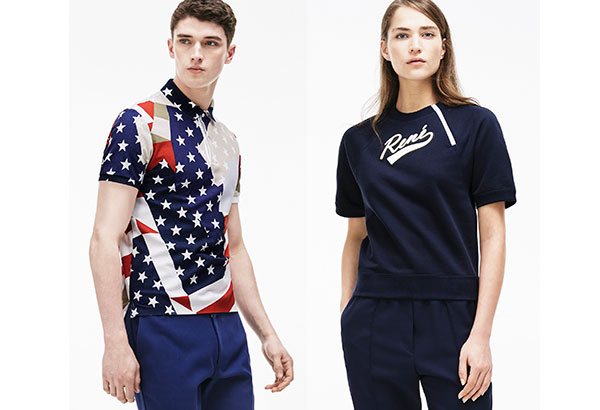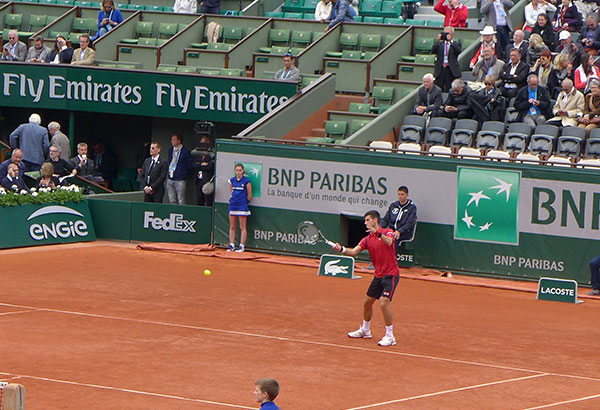It’s a great match between Lacoste and Roland Garros
PARIS, France — Some 30 minutes west of Paris center, where the arrondissements give way to suburban gardens, not far from the idyllic spread of Versailles, things are generally quiet. It’s only this time of year — late May — when the streets surrounding Roland Garros Stadium swarm with activity, clogged with traffic and security checkpoints. A somewhat new phenomenon since terrorists struck Paris last year: lines stretching around the block half a kilometer leading to the tennis mecca, with police doing pat-downs of every ticket holder — and woe betide those who bring bags inside the stadium, adding to inspection time.
If you’re lucky enough to be there on Lacoste’s invite, the line breezes through quicker; soon you’re inside Salon Premium Lacoste, watching the matches on big-screen TVs with a glass of Champagne and a foie gras lunch. Lacoste has always done things with style, and attending the French Open could be no different.
In many ways, Lacoste has become synonymous with Roland Garros stadium, home to the French Open. The two are welded together as indelibly as a laser etching your name onto a souvenir tennis ball. Ever since the stadium was built in 1928, after René Lacoste and his co-players — known as the Musketeers, and including Jacques Brugnon, Henri Cochet and Jean Borotra — won a victory at New York’s Davis Cup, Roland Garros has been a symbol of Gallic pride and accomplishment. The French Open became a key Grand Slam title, and one of its key players, Lacoste, became legendary for his fashion apparel and other innovations of the game, including the first tennis ball-serving machine. (The famous crocodile logo came about, legend has it, after Lacoste made a bet against an Australian player in the 1923 Davis Cup; the prize, which he lost, was an alligator bag; still, Lacoste soon became known as “The Crocodile” for his on-court tenacity.)
In a way, you could say Lacoste helped build this stadium, where French enthusiasm is predictably off the charts. Roam the walkway leading to Court Suzanne Lenglen where vendors sell Roland Garros merchandise — yes, engraved tennis balls, key chains, pens, posters, rackets, souvenir gym bags and clutches — and you’ll see blue-clad ball girls and boys doing warm-up exercises; French hipsters dressed in 1920s tennis attire, kids bouncing basketball-sized tennis balls, an overhead camera disguised as an airplane (a reference to Garros’ fame as an aviator) crossing the main courts on a string between points; tennis clinics, a “Tenniseum” containing match trophies and archival footage over the years, a Roland Garros Lab where visitors are invited to play against a robot opponent, and a sign announcing relative locations of those other tournaments outside of Paris (“Wimbledon 365 kms,” “Flushing Meadows 5,839 kms,” “Melbourne Park 16,950 kms”).
But all eyes are on Roland Garros today, where first-round fans get the biggest bang for their buck — a smorgasbord of matches unfolding on three main courts at once: Suzanne-Lenglen (where Nadal pulled apart Australian player Sam Groth in under 90 minutes in the first round, dropping only three games), bullring-shaped Court No. 1, and Philippe-Chatrier, where on this day Andy Murray was struggling to finish off Czech player Radek Stepanek in five sets, and Serb master Novak Djokovic dissected Taiwan player Yen-Hsun Lu in straight sets. On the same court French player Jo-Wilfried Tsonga took out German Jan-Lennard Struff, and Serena Williams breezed by Slav player Magdalena Rybarikova in three sets.
It was a thrill to watch Djokovic sharpening his knives in the first round. For many, Nole is the executioner of tennis, almost like the Ramsey Bolton of the Grand Slam. Not pretty to watch, perhaps, but merciless. And lethal. Will he finally win a French Open, with top victor Nadal out from a wrist injury, or will the clay — or possibly last year’s winner Stan Wawrinka — topple him on his 12th try? For Southeast Asian media, this was a special treat: taking in the Roland Garros experience, courtesy of iconic brand Lacoste. Says Lacoste marketing and communications director Michelle Cheung: “We wanted you to experience the Frenchness of the brand in its own environment.” And what better immersion than sitting in the stands of Roland Garros, or visiting Lacoste’s key factory the following day in Troyes, a quaint town with still-standing medieval architecture some two hours southeast of Paris? (See sidebar)

Lacoste Fashion show polo in flag print noppe pique? (right) Fashion show sweatshirt in fleece with short sleeves
Fashion has always been a key ingredient of this elegant game. Looking at archival photos of René Lacoste in the Roland Garros Lab exhibit, it’s hard to imagine, perhaps, the dapper and lanky Frenchman playing such an amazing game in such refined clothes — belted linen pants, button-down shirts, a perfectly pitched cap — but it goes to show how Lacoste can make its sporty style seem both functional and apparently effortless. You may play with the force of every molecule of your being, but you can still look cool and elegant doing it. (Indeed, Lacoste’s own French player, Benoit Paire, got as far as the second round in his white striped polo.)
With young Portuguese designer Felipe Oliveira Baptista aboard as creative director in 2011, the Lacoste brand has sought to redefine itself through core strengths: its Frenchness, its playful attitude, its ties to sport. Indeed, “Life is a beautiful sport,” as the recent ads go. Last year Baptista’s fashion collection played off a Wes Anderson aesthetic, referencing The Royal Tenenbaums and its ’70s boho tennis look; this year the collection focused on elements of the French flag, perhaps a symbol of national identity and pride a year after the Paris terror attacks, perhaps something more inclusive.
Since selling the brand to Swiss group Freres Maus two years ago for 1.3 billion euros, there’s been an emphasis on Lacoste’s core identity: they are a French brand. Full stop. “Now we’re talking one brand, one voice,” notes Cheung. Since putting all of its licensing under Freres Maus, “We’re able to bring more coherence among all the categories. We can collaborate more with other brand categories. Like footwear, it’s independent, but we can launch to match with iconic polos and shirts as well.”
Still, the company faced a conundrum: not only did their research show many customers globally were unaware they were a French brand, even some French people didn’t know this fact! Incroyable!
Back in the Philippines, everybody knows Lacoste. It has bigger sales here than anywhere else in Southeast Asia. Introduced to these shores back in the ’60s, the brand has 98 percent name recognition among locals, according to Cheung, and she credits this to distributor Stores Specialists Inc. (SSI). “They established it as quite a premium brand even at that time,” and SSI notes Lacoste is still a top seller among Filipino males. “Another reason SSI does so well is they have very good retail staff,” Cheung adds. “They work for Lacoste for many years, so they know the customers well.” Though Filipinos mostly know the brand for its polos, she notes an interesting angle: 26 percent of Philippine store sales come from leather goods. That’s the women’s market. How did that happen? “In the last three years, we introduced the L.12.12 luxury shopping bag. It’s very versatile, and the price point is very accessible. We have many colors and shapes so ladies will just grab a few.”
And while research shows the Lacoste demographic has been mostly 45-plus males, “from a brand standpoint we wish to target 35-plus. We have moved from sports to lifestyle. It’s more attitude in the wardrobe.”

Game, set, Lacoste: Will Serb champion Novak Djokovic win his first French Open this year? Either way, Lacoste emerges a winner.
Look at Baptista’s eye-popping flag designs for spring-summer 2016, shown off at the Lacoste showroom on Rue De La Chaussee D’Antin: slashes of red, blue and white are color blocked for a youthful change-up; the LIVE! line updates stitching details and patterns for a brand-new Lacoste style; and to seal the brand’s identity, the French Open line goes back to lively images of rackets, balls and crocodiles across clothes even your grandkids would love.
What Lacoste has done is refocus on its identity, the enduring story of a French tennis pioneer, paired with the vibrant history of Roland Garros. To that foundation they’ve added a young designer who is willing to play around with the image. From sportswear, the brand has now pivoted to calling itself “premium casual wear.” But always French in origin, of course.















